NIGMS, along with other NIH Institutes and Centers, has partnered with the National Institute on Aging to grow the community of scientists actively engaged in research focused on Alzheimer’s Disease and Alzheimer’s Disease-Related Dementias (AD/ADRD). Details of this year’s AD/ADRD supplement program are provided in NIA’s Notice NOT-AG-18-008. If your research, research training, or research capacity-building grant is not currently focused on AD/ADRD and you have an inspiring new idea of potential value to the field that is within the scope of the funded Specific Aims of your current award, please consider this opportunity.
Research related to AD/ADRD might fall within the scope of an already-funded NIGMS award originally focused on, for example, an enzyme, transporter, or metabolic pathway being studied for its basic biological or physiological role (or a non-AD/ADRD-related medical condition) if you have recognized an exciting new implication for AD-type pathologies or their treatment. Funded projects developing analytical methods, tools or technologies, drug molecules, or drug delivery systems not previously intended for application to AD/ADRD might now appear to have potential in this area. Potential applicants are strongly encouraged to contact their program director to discuss their ideas for AD/ADRD research and how those relate to the Specific Aims currently funded. Decisions about scope are strictly the purview of NIH. Center and Resource grants that allow non-specified pilot projects should consider adding AD/ADRD projects if interest and expertise exist.
Continue reading “Administrative Supplements to Add Research on Alzheimer’s Disease and Alzheimer’s Disease-Related Dementias”




